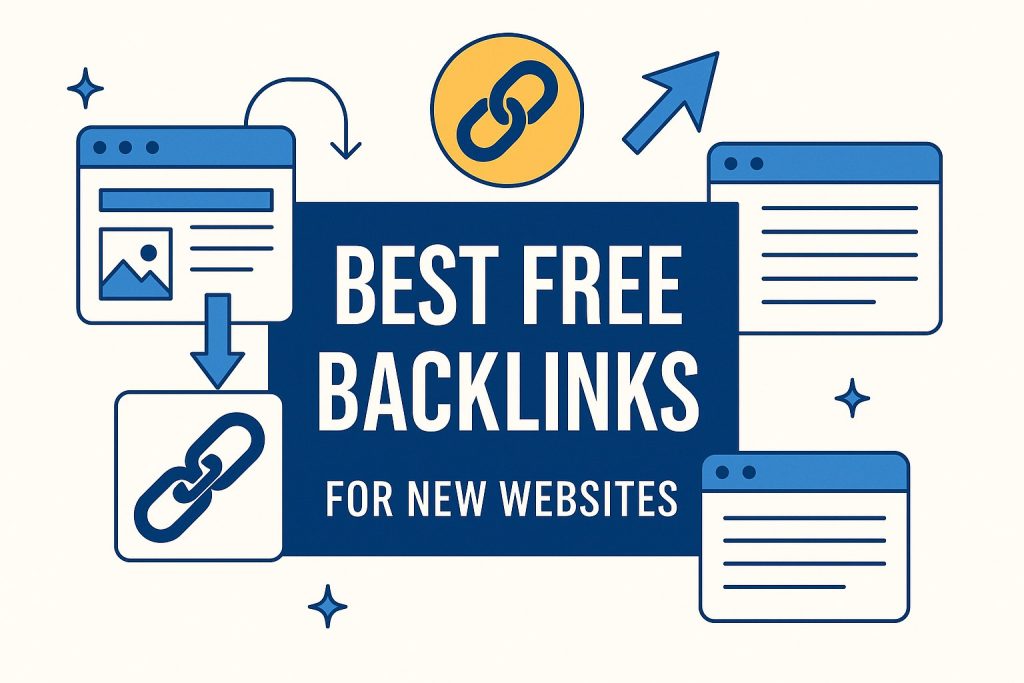Starting a new website or business is exciting, but getting noticed on Google can feel like shouting into the void. One of the smartest ways to build authority and improve your ranking is by earning high-quality backlinks — links from other websites pointing to yours. This comprehensive guide on the Best Free Backlinks for New Websites will help beginners, bloggers, and small business owners learn where to start a new business, how to earn links naturally, and how to use these backlinks to boost organic visibility without spending a single dollar.

Begin with an engaging introduction that explains why backlinks are like votes of confidence in the eyes of search engines. Describe how a brand-new website often struggles to gain authority because it lacks inbound links.
Briefly connect this with Google’s E-E-A-T principle (Experience, Expertise, Authoritativeness, Trustworthiness) — highlighting how free backlinks can strengthen a site’s credibility and help Google trust your content faster. Introduce the main idea that while paid backlinks can be risky or against Google’s guidelines, earning free backlinks through smart strategies is both ethical and sustainable.
What Are Backlinks and Why They Matter for New Websites
A backlink is simply a hyperlink from one website to another. When another site links to yours, it’s like a digital endorsement — saying, “Hey, this source is worth checking out.”
Search engines interpret backlinks as a signal of authority and trust. That’s why backlinks remain one of Google’s top three ranking factors. For new websites with little authority, backlinks are crucial to:
- Help Google discover your pages faster.
- Increase domain authority (DA) and trust score.
- Boost rankings for your targeted keywords.
- Drive referral traffic from other sites.
But not all backlinks carry the same weight. A link from Forbes or HubSpot will always have more SEO value than a random blog or spammy directory. What matters most is quality over quantity — a few high-quality backlinks can do more than hundreds of low-quality ones.
Understanding What Makes a High-Quality Backlink
Before diving into backlink sources, it’s crucial to understand what makes a backlink truly powerful. A high-quality backlink doesn’t just send traffic—it strengthens your website’s reputation and helps Google see you as a trusted source. The best backlinks come from relevant, authoritative, and well-trafficked websites that naturally connect with your niche. Let’s break down the five key elements that determine backlink quality and how you can apply them to your SEO strategy.
1. Relevance
Relevance is the backbone of every strong backlink. When a link comes from a site that shares your industry or topic focus, Google views it as contextually meaningful. For instance, if your website focuses on digital marketing, a backlink from a marketing or SEO blog carries far more weight than one from a cooking site. Relevant backlinks prove to search engines that your content genuinely belongs to a specific niche, boosting your topical authority and keyword relevance in search results.
2. Authority
Authority measures how trustworthy the linking site is. Links from high Domain Authority (DA) or Domain Rating (DR) websites—like Forbes, HubSpot, or Search Engine Journal—can significantly impact your ranking. These authoritative domains already have strong credibility, so when they link to your site, they transfer a portion of their trust to you. However, not every powerful backlink must come from a global brand—local, industry-relevant sites with solid reputations also contribute valuable authority signals to your SEO growth.
3. Anchor Text
Anchor text is the clickable word or phrase used for your backlink, and it plays a vital role in how Google understands your page’s context. A natural, well-written anchor text such as “learn more about content marketing strategies” helps search engines relate your page to the right keywords. Avoid over-optimization or repetitive phrases like “best free backlinks for SEO” on every link. For an in-depth understanding, read my full content post on Internal Linking, which shows how smart anchor text strengthens site structure and link equity.
4. Traffic Source
A backlink from a website that already attracts genuine visitors has higher value. It’s not just about SEO power—it’s also about real people discovering your brand. When your link is placed on a page that consistently earns organic traffic and the same time you can build brand awareness, also you’ll get referral visitors who can turn into leads, subscribers, or customers. This combination of authority and engagement makes traffic-backed backlinks twice as valuable, as they contribute both to business ranking growth and measurable business visibility over time.
5. Placement and Context
Where your backlink appears on a page matters. A link embedded naturally within relevant content carries much more weight than one hidden in a footer, sidebar, or author bio. Context-rich placements tell Google that your link belongs there because it supports the reader’s understanding of the topic. For instance, being referenced in a paragraph discussing SEO strategies makes your backlink meaningful and trustworthy. Always aim for editorial, in-content links that blend seamlessly into the article instead of looking forced or promotional.
Why Free Backlinks Matter for New Websites
When your domain is brand new, it starts from zero — no authority, no trust, and often no traffic. Free backlinks help you start building that foundation.
Unlike paid backlinks (which can trigger Google penalties if done wrong), free backlinks are organic, sustainable, and 100% white-hat. They build genuine authority over time.
Think of it as growing a tree. Paid backlinks might look like fast fertilizer, but free backlinks — earned through real effort — grow your roots deeper and stronger.
For example, a small Bangladeshi entrepreneur launching a new e-commerce store for handmade decor can get listed in Google Business Profile, Yelp, and a few local directories. These listings alone can help the site appear in local searches and Google Maps, bringing in the first batch of real customers — all for free.
Best Free Backlink Sources You Can Use Today
Here’s the master list — practical, safe, and effective ways to get best free backlinks for your new website.
1. Business Directories and Local Listings
Get your business listed in popular directories like:
- Google Business Profile
- Bing Places
- Yelp
- Hotfrog
- Local.com
These links may often be nofollow, but they strengthen your brand trust and help Google verify your business details. Local directories are especially vital for businesses in Bangladesh or South Asia targeting nearby customers.
2. Social Media Profile Links
Your social profiles are some of the easiest backlinks you can earn.
Platforms like LinkedIn, Facebook, Instagram, Pinterest, and YouTube allow you to include your website link in your bio or “About” section.
They not only pass traffic but also help build brand visibility and social proof.
Check the Entire List here-
- howcube.com
- weebly.com
- mediafire.com
- archive.org
- pinterest.com
- facebook.com
- x.com
- linkedin.com
- youtube.com
- instagram.com
- en.gravatar.com
- change.org
- sedo.com
- aol.com
- soundcloud.com
- sourceforge.net
- themeforest.net
- addthis.com
- quora.com
- medium.com
- disqus.com
- goodreads.com
- academia.edu
- kickstarter.com
- buzzfeed.com
- wikihow.com
- box.com
- livejournal.com
- evernote.com
- answers.com
- about.me
- behance.net
- tiktalk.com
- flickr.com
So, if you would like to boost traffic, you have to role on 360 degree digital marketing.
3. Forum and Community Participation
Joining discussions on platforms like Reddit, Quora, or niche-specific forums builds authority. When you answer questions genuinely and link back to a helpful blog post on your site, it drives qualified traffic and creates contextual backlinks
4. Guest Posting
One of the oldest yet most powerful ways to earn backlinks is through guest posting. You write an article for another website in your industry, and they link back to you in the bio or content.
The trick? Focus on value exchange, not link exchange.
Read our full guide on digital marketing strategies to learn how guest posting builds both brand awareness and SEO authority.
5. Q&A Platforms
Answer questions on Quora, Stack Overflow, or niche-specific communities.
When your answers include valuable insights (and a relevant link), they can appear in Google’s featured snippets — giving both visibility and authority.
6. Web 2.0 Submission Blog Sites
Create mini-blogs on Medium, Blogger, WordPress.com, or Tumblr.
Post original, unique summaries of your articles with a link back to the full version on your main site.
This helps you own multiple online spaces while strengthening your backlink network.
Here is the core Web 2.0 submission blog sites list for you!
- Blogger.com
- Medium.com
- WordPress.com
- Tumblr.com
- microsoft.com
- sites.google.com
- github.com
- my.opera.com
- 4shared.com
- change.org
- wikipedia.org
- lyrics.wikia.com
- box.com
- Xing.com
7. Press Release Submission Sites
Press release submission is one of the most professional ways to earn free backlinks while gaining visibility for your brand. Platforms like PRLog, OpenPR, and OnlinePRMedia allow businesses to share announcements about product launches, events, or partnerships. Each submission includes backlinks to your website, boosting both SEO and brand credibility. A well-written press release can attract journalists, bloggers, and potential customers. To make the most of this strategy, learn how to craft compelling, newsworthy released in my detailed guide on PR strategies.
8. Profile Creation Sites
Create detailed profiles on Crunchbase, About.me, AngelList, Behance, or ProductHunt — all of which allow backlinks to your website.
For example, a new marketing consultant can create a Crunchbase profile linking to their official site for both SEO and brand visibility.
9. Image Sharing Platforms
If you design infographics or visuals, share them on Pinterest, Flickr, or Imgur. Add your website in the description or watermark to get credit for your visuals.
10. HARO (Help a Reporter Out)
Sign up for HARO and respond to journalist queries in your niche.
If they use your quote, you’ll often get a backlink from high-authority sites like Forbes, Business Insider, or TechCrunch.
It’s one of the most powerful free backlink tactics in modern SEO.
11. Specific Communities
Join communities aligned with your expertise. For example:
- Dribbble and Behance for designers.
- GitHub for developers.
- Houzz for architects.
These backlinks are contextually relevant and highly trusted.
12. Testimonial Backlinks
Write testimonials for tools or services you use — for example, your hosting company, SEO tool, or CRM platform. Many brands feature testimonials with backlinks to your site, offering a high-authority link in exchange for genuine feedback.
Step-by-Step Strategy to Earn Free Backlinks Naturally
Now that you know where to find them, here’s the process to earn them strategically.

- Optimize Your Website First
Make sure your website is technically sound. Site speed, mobile-friendliness, and crawlability matter.
Learn more from my technical SEO guide — because before earning links, your site must deserve them. - Create Link-Worthy Content
Write helpful guides, research posts, and infographics that others want to cite. Original data or case studies attract organic backlinks naturally. - Engage in Outreach
Build relationships with bloggers, industry peers, and media outlets. Don’t just ask for links — offer insights, quotes, or collaborations. - Leverage Guest Posting and Collaborations
Guest post on reputable sites and co-author content. It builds mutual trust and backlinks simultaneously. - Track and Analyze Your Backlinks
Use tools like Ahrefs, Ubersuggest, or Moz to monitor new backlinks and check quality. Remove spammy links using Google’s Disavow tool if needed.
Common Mistakes to Avoid When Building Free Backlinks
Many beginners make errors that cost them time — and sometimes penalties. Here’s what to avoid:
- Using automated backlink generators. They create spammy links that Google easily detects.
- Ignoring niche relevance. A link from a cooking blog won’t help your tech site.
- Overusing exact-match anchor texts. It looks manipulative.
- Forgetting nofollow/dofollow balance. A healthy profile includes both.
- Skipping on-page SEO. Backlinks alone can’t rank poor-quality pages.
Each backlink should serve a purpose — either boost authority or send meaningful traffic.
How to Measure the Impact of Free Backlinks
Backlinking is a long game — it takes patience. But you can measure results using these metrics:

- Domain Authority (DA) and Domain Rating (DR): Tools like Ahrefs and Moz track how your authority improves.
- Organic Traffic Growth: Check Google Analytics for gradual traffic increases.
- Keyword Rankings: Track how your pages move up in SERPs.
- Referral Traffic: Identify which backlinks actually bring visitors.
Monitoring these numbers monthly keeps your strategy data-driven and effective.
Combining Free and PR Backlink Strategies
Free backlinks build your foundation, but as your brand grows, mixing them with earned editorial mentions can accelerate growth.
For instance, after establishing organic authority, you can invest in digital PR campaigns or niche collaborations — but always ethically. Never buy links from PBNs (Private Blog Networks) or shady marketplaces.
Instead, focus on relationships, collaborations, and genuine value exchanges.
Key Takeaways: Building Authority the Right Way
Backlinks are the backbone of SEO success. For a new website, the journey starts small — one profile here, one guest post there, one thoughtful comment somewhere.
Over time, these small actions compound into big results. Google rewards consistency and authenticity.
To summarize:
- Start with easy wins like directories, social media, and forums.
- Create shareable, link-worthy content.
- Build relationships, not just backlinks.
- Focus on sustainable, ethical SEO practices.
And most importantly, stay patient. Building authority takes time — but it’s worth every step.


